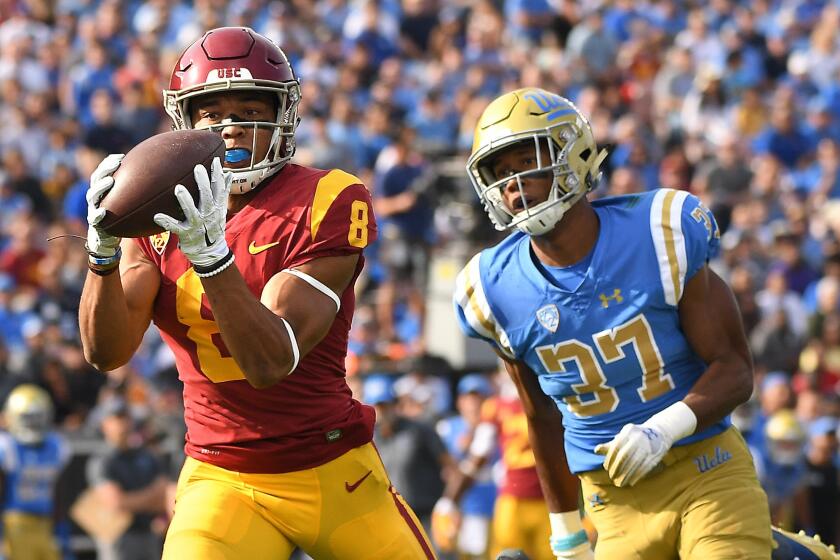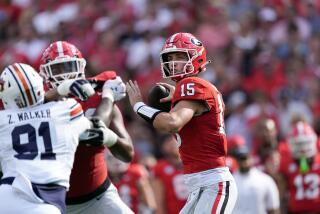News Analysis: NCAA makes move on name, image and likeness use, but there’s a long way to go

- Share via
Only weeks after the NCAA called California’s Senate Bill 206 “unconstitutional” and an “existential threat,” the NCAA Board of Governors voted unanimously Tuesday to permit college athletes to benefit from the use of their name, image and likeness “in a manner consistent with the collegiate model.”
On the surface, this was a major turnabout by the NCAA. Exactly how athletes would benefit, however, is still to be determined. For example, the NCAA statement included the word “compensation” only once, as in: “Make clear that compensation for athletics performance or participation is impermissible.”
“The NCAA has been signaling for months that such benefits would not be actual compensation,” said Ramogi Huma, the executive director of the National College Players Assn.
Still, the NCAA saying that it is open to reform on the issue is significant. Ohio State President Michael V. Drake, chair of the NCAA governing board, said in a statement that the organization “must embrace change to provide the best possible experience for college athletes,” then immediately added, “Additional flexibility in this area can and must continue to support college sports as a part of higher education.”
If that sounded vague, at least this much is clear: If name, image and likeness rights are granted to players in a way that falls in line with how things have always been done, with artificially set limits for compensation and regulation, then the organization’s attempt at national-level reform will not meet the free-market standards set in California’s landmark legislation, signed into law by Gov. Gavin Newsom in late September.
Reached by The Times on Tuesday, California Sen. Nancy Skinner, the author of SB 206, began by saying, “It’s a good day.”
Historical Basketball League wants to offer salaries to top national and international prep players while setting them up with a clear path to higher education.
She did not want to show a lack of appreciation for the NCAA’s willingness to consider the issue further, saying, “I’m just thrilled that California leadership is a game changer once again. And I think the NCAA’s vote today shows great promise.”
Let there be no confusion, though. That promise, for state legislators in California and in other states considering bills like SB 206, remains unfulfilled.
“The devil’s in the details,” Skinner said. “For example, what does the NCAA mean by ‘consistent with the collegiate model’? Because here in California, and I think most states, students on college campuses other than athletes have completely free rights regarding generating income from their skills and talents. So, we want to make sure that the NCAA does not have in mind arbitrary limitations.”
The NCAA formed a working committee in the summer to examine the issue. Tuesday, the organization laid out principles that the group has recommended that will guide the philosophy behind rule changes to come.
Among them (with key phrasing addressed in italics):
- “Assure student-athletes are treated similarly to non-athlete students unless a compelling reason exists to differentiate.”
- “Ensure rules are transparent, focused and enforceable and facilitate fair and balanced competition.”
- “Make clear the distinction between collegiate and professional opportunities.”
- “Make clear that compensation for athletics performance or participation is impermissible.”
- “Reaffirm that student-athletes are students first and not employees of the university.”
- “Protect the recruiting environment and prohibit inducements to select, remain at, or transfer to a specific institution.”
With those principles in place, could any change the NCAA chooses to embrace be meaningful to college athletes, particularly the ones in football and men’s basketball who help to bring in millions of dollars each year? What new benefit could the NCAA be permitting for players’ use of their name, image and likeness that aligns with these guidelines?
California’s law does not set limits on what an athlete can receive from use of his or her name, image and likeness, other than saying an athlete cannot endorse a product that is in direct competition with a school sponsorship deal.
“This is a step in the right direction, and the NCAA deserves credit for finally affirming what has been common sense to so many for so long,” Newsom said in a statement. “California will be closely watching as the NCAA’s process moves forward to ensure the rules ultimately adopted are aligned with the legislation we passed this year. Collegiate student athletes put everything on the line — their physical health, future career prospects and years of their lives — to compete. Colleges reap billions from these student athletes’ sacrifices and success but, in the same breath, block them from earning a single dollar. That model puts institutions ahead of the students they are supposed to serve, and deserves to be disrupted.”
Historical Basketball League wants to offer salaries to top national and international prep players while setting them up with a clear path to higher education.
The NCAA appears committed to regulating name, image and likeness benefits to ensure fair recruiting between schools. The fear is that a booster for one school will pay far above perceived market value for an endorsement deal with a player in order to secure that player’s commitment to the school.
“That’s kind of happening [now],” Skinner said, referencing under-the-table payments to players that lead to NCAA enforcement investigations.
The NCAA said that its working committee on name, image and likeness will “continue to gather feedback through April on how to best respond to the state and federal legislative environment and to refine its recommendations on the principles and regulatory framework. The board asked each division to create any new rules beginning immediately, but no later than January 2021.”
“The NCAA has failed on this issue once again,” Huma said. “This is another attempt at stalling on this issue.”
SB 206, as it is written, would not go into effect until January 2023. That is more than three years away, ample time to bridge the gap between what the California law states and the NCAA’s vision for what name, image and likeness reform would look like.
Some NCAA and college officials are predicting doom for sports programs in wake of new California law enabling athletes to receive payment for use of their name, image or likeness. They said similar things 50 years ago, about Title IX.
“What the NCAA is trying to do here is say, ‘OK, we’re going to come closer to where you want us to be,’ ” said Matthew Cantor, an antitrust attorney at Constantine Cannon LLP in New York who has followed the NCAA’s numerous antitrust court battles. “They will want some degree of assurance from the states that their reformed policies are consistent with the passed law, or they’ll [try to] get modifications through the legislature.”
Cantor said that if compromise with California can’t be reached by 2023, the NCAA could elect to ask for a preliminary injunction from the courts that would stop the law from going into effect. The NCAA could ultimately file litigation through a “Dormant Commerce Clause,” which keeps states from interfering with interstate commerce that is governed by Congress.
To put it in simpler terms, California against the NCAA is just getting started. Tuesday, the NCAA offered an olive branch, and California made it clear the organization will need to stretch further from its comfort zone.
“I definitely have an open mind,” Skinner said, “but will also be monitoring closely.”
More to Read
Go beyond the scoreboard
Get the latest on L.A.'s teams in the daily Sports Report newsletter.
You may occasionally receive promotional content from the Los Angeles Times.













